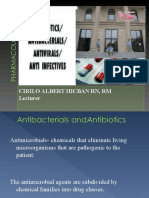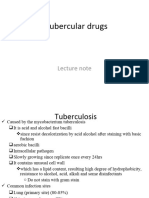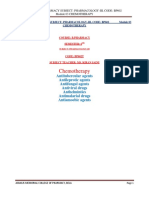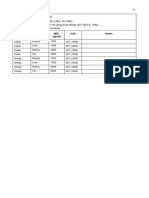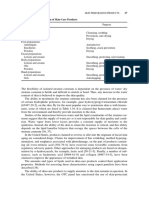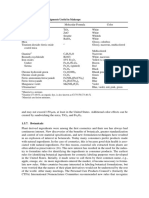SPECTINOMYCIN
SPECTINOMYCIN
Uploaded by
PapaindoCopyright:
Available Formats
SPECTINOMYCIN
SPECTINOMYCIN
Uploaded by
PapaindoOriginal Description:
Copyright
Available Formats
Share this document
Did you find this document useful?
Is this content inappropriate?
Copyright:
Available Formats
SPECTINOMYCIN
SPECTINOMYCIN
Uploaded by
PapaindoCopyright:
Available Formats
202 SPECTINOMYCIN VeterinarySystemic
SPECTINOMYCIN VeterinarySystemic
Some commonly used brand names for veterinary-labeled products are: Paratyphoid (treatment)1Chicks, newly hatched: Spectinomycin hydro-
Adspec Sterile Solution; AmTech Spectam Scour-Halt; Bovispec Sterile chloride injection is indicated in the control of mortality and to lessen
Solution; Spectam; Spectam Injectable; Spectam Oral Solution; Spectam severity of infections caused by Salmonella typhimurium{R-17}.
Scour-Halt; Spectam Soluble Powder; and Spectam Water Soluble. Pneumonia, bacterial (treatment)Cattle: Spectinomycin sulfate injec-
Note: For a listing of dosage forms and brand names by country tion is indicated in the treatment of pneumonia (bovine respiratory
availability, see the Dosage Forms section(s). disease) associated with M. haemolytica, P. multocida, and H. somnus in
cattle{R-21; 25}.
CATEGORY: Salmonella infantis infection (treatment)1Chicks, newly hatched: Spec-
Antimicrobial (systemic). tinomycin hydrochloride injection is indicated in the control of
mortality and to lessen severity of infections caused by S. infantis{R-17};
INDICATIONS: however, S. infantis is not considered to be a major pathogen in the
Note: Bracketed information in the Indications section refers to uses that poultry industry.
either are not included in U.S. product labeling or are for products not Synovitis (prophylaxis)Chickens, broiler: Spectinomycin powder for oral
commercially available in the U.S. solution is indicated to aid in the prevention of mortality associated
with infectious synovitis due to susceptible Mycoplasma synoviae{R-2;
18}
.
GENERAL CONSIDERATIONS Synovitis (treatment)
Spectinomycin is an antibiotic that is active against a variety of Chickens, broiler1: Spectinomycin powder for oral solution is indicated
aerobic gram-negative and gram-positive organisms{R-3; 4} as well to aid in the control of mortality associated with infectious synovitis
as Mycoplasma species{R-7}. Spectinomycin is used clinically, due to susceptible M. synoviae{R-18}.
primarily for its activity against gram-negative organisms; some Chicks, newly hatched1: Spectinomycin hydrochloride injection is
gram-positive organisms may also be susceptible to this agent. It indicated in the control of mortality and to lessen severity of
has in vitro and in vivo activity against Mannheimia (Pasteurella) infections caused by susceptible M. synoviae{R-17}.
haemolytica, Pasteurella multocida, and Haemophilus somnus{R-25}. [Fowl cholera (treatment)]Turkeys: Spectinomycin hydrochloride injec-
Anaerobic organisms are generally resistant{R-7}. Spectinomycin is tion is indicated to reduce mortality due to fowl cholera caused by
usually bacteriostatic at therapeutic doses{R-5}. As an aminocyclitol sensitive strains of Pasteurella multocida{R-1}.
antibiotic, spectinomycin is structurally and functionally similar to
the aminoglycoside antibiotics, which are also aminocyclitols.
ACCEPTANCE NOT ESTABLISHED
Spectinomycin lacks the toxic effects of the aminoglycoside antibi-
Colibacillosis (treatment)1[Ducklings]: There are insufficient data to
otics; however, its use is limited by the ready development of
establish the safety and efficacy of spectinomycin in the treatment of
bacterial resistance{R-5}.
colibacillosis in ducklings; however, in one study, subcutaneous admin-
istration of spectinomycin reduced the mortality and improved weight
gain in 1-day-old ducklings experimentally infected with E. coli{R-10}.
ACCEPTED
Infections, bacterial (treatment), including
Air sacculitis (treatment)1Turkey poults, 1- to 3-day-old: Spectinomycin
Respiratory tract infections (treatment)[Pigs]1: There are insufficient
hydrochloride injection is indicated to aid in the control of air sacculitis
data to establish the safety and efficacy of spectinomycin injection in
associated with Mycoplasma meleagridis sensitive to spectinomycin
{R-17} the treatment of respiratory infections and systemic infections due to
.
susceptible organisms in pigs; however, the parenteral administra-
Chronic respiratory disease (CRD) (prophylaxis)Chickens, broiler:
tion of spectinomycin to pigs has been used in clinical practice to
Spectinomycin powder for oral solution is indicated to aid in the
treat these infections{R-5}.
prevention of mortality due to CRD associated with susceptible
Mycoplasma gallisepticum{R-2; 18}. 1
Not included in Canadian product labeling or product not commercially
Chronic respiratory disease (CRD) (treatment)
available in Canada.
Turkey poults, 1- to 3-day-old1: Spectinomycin hydrochloride injection
is indicated to aid in the control of CRD associated with Escherichia
coli{R-17}. REGULATORY CONSIDERATIONS
Chickens, broiler: Spectinomycin powder for oral solution is indicated to U.S.
aid in the control of mortality due to CRD associated with susceptible Spectinomycin oral solution is labeled for use in piglets younger than 4
Mycoplasma gallisepticum{R-2; 18}. weeks of age or weighing < 6.8 kg{R-3; 4}.
Colibacillosis (treatment)1Chicks, newly hatched: Spectinomycin Spectinomycin injection is labeled for use only in newly hatched chicks
hydrochloride injection is indicated in the control of mortality and to and in 1- to 3-day-old turkey poults{R-17}.
lessen severity of infections caused by E. coli{R-17}. Spectinomycin is not labeled for use in birds producing eggs for human
Enteritis, bacterial (treatment)Piglets: Spectinomycin oral solution is consumption{R-18}.
indicated in the treatment of bacterial enteritis (white scours) Withdrawal times have been established for the use of spectinomy-
associated with E. coli in piglets younger than 4 weeks of age{R-3; 4}. cin in newly hatched chicks{R-17}, broiler chickens{R-18}, 1- to
2003 Thomson MICROMEDEX All rights reserved
SPECTINOMYCIN VeterinarySystemic 203
3-day-old turkey poults{R-17}, and piglets{R-4}(see the Dosage Forms administration of spectinomycin{R-7}. Tissue/serum ratios of spectino-
section). mycin usually do not exceed 0.25 to 0.5 and are much lower in brain,
Canada aqueous humor, and bone{R-22}.
Spectinomycin is not labeled for use in birds producing eggs for human Volume of distribution (VolD):
consumption{R-1}. Cows0.295 Liter per kg (L/kg){R-13}.
Spectinomycin injection is not labeled for use in turkeys weighing Ewes0.307 L/kg{R-13}.
< 0.5 kg{R-1}.
Withdrawal times have been established for the use of spectinomycin Protein binding: CowsLow (approximately 10%){R-13}.
in broiler chickens{R-2}, piglets{R-3}, and turkeys{R-1}(see the Dosage
Forms section). Biotransformation: Spectinomycin does not appear to undergo any
significant metabolism. In swine, it is excreted unchanged in the urine
CHEMISTRY following intramuscular administration{R-7}.
Source: Spectinomycin is a product of Streptomyces spectabilis{R-5; 25}.
Chemical group: Aminocyclitol{R-5}. Half-life: Elimination
Chemical name: Cows: 1.01{R-13} to 1.2 hours{R-7}.
Spectinomycin hydrochloride4H-Pyrano[2,3-b][1,4]benzodioxin-4-one, Ewes: 1.01 hours{R-13}.
decahydro-4a,7,9-trihydroxy-2-methyl-6,8-bis(methylamino)-, dihy- Pigs: 0.98 hour{R-7}.
drochloride, pentahydrate{R-6}.
Spectinomycin sulfate tetrahydrateDecahydro-4a,7,9-trihydroxy- Peak serum concentration/Time to peak serum concentration:
2-methyl-6,8-bis(methylamino)-4H-pyrano[2,3-b][1,4]benzodioxin- Calves, preruminating20 mcg/mL between 0.33 and 0.67 hours
4-one sulfate, tetrahydrate{R-25}. following an intramuscular dose of 10 mg/mL{R-7}.
Molecular formula: Spectinomycin hydrochlorideC14H24N2O7 CowsApproximately 55 micrograms per mL (mcg/mL) at 1 hour
2HCl 5H2O{R-6}. following an intramuscular dose of 20 mg per kg of body weight
Molecular weight: Spectinomycin hydrochloride495.35{R-6}. (mg/kg){R-13}.
Description: Spectinomycin Hydrochloride USPWhite to pale-buff Dogs
crystalline powder{R-16}. Intramuscular: 78 mcg/mL 40 minutes following an intramuscular
pKa: 6.95 and 8.70{R-23}. dose of 40 mg/kg.
Solubility: Spectinomycin Hydrochloride USPFreely soluble in Oral{R-7}:
water; practically insoluble in alcohol, in chloroform, and in 22 mcg/mL approximately 4 hours following a dose of
ether{R-16}. 100 mg/kg.
80 mcg/mL approximately 4 hours following a dose of 500 mg/kg.
PHARMACOLOGY/PHARMACOKINETICS EwesApproximately 53 mcg/mL at 1 hour following an intramuscular
Note: Unless otherwise noted, pharmacokinetic data in this section are dose of 20 mg/kg{R-13}.
based on a single intravenous injection of spectinomycin.
The pharmacokinetics and detection of spectinomycin do not appear to Elimination:
be influenced by administration in combination with lincomycin{R-7}; Following intramuscular administrationSpectinomycin is rapidly
some of the pharmacokinetic data in this section are derived from absorbed, then quickly eliminated from plasma and tissues
studies in which lincomycin and spectinomycin were administered through renal excretion{R-7}. Because of this rapid excretion, drug
concomitantly{R-7}. accumulation is not observed following repeated administra-
tion{R-7}. Renal impairment may cause accumulation of the active
Mechanism of action/effect: Spectinomycin binds to the 30S ribo- drug{R-22}.
somal subunit of the microorganism and inhibits protein synthesis by Following oral administrationBecause spectinomycin is poorly
preventing elongation of the polypeptide chain at the translocation absorbed from the gastrointestinal tract, it is excreted mostly in the
step{R-5}. feces{R-7}.
Absorption: Spectinomycin is only slightly absorbed from the gas-
trointestinal tract{R-7}; however, it is rapidly absorbed following
PRECAUTIONS TO CONSIDER
intramuscular administration{R-7}. In cattle, spectinomycin is com-
pletely bioavailable following intramuscular administration{R-7}. LACTATION
Repeated administration in cattle does not appear to result in tis- Cows: In one experimental study, the milk-to-serum ratio of spectino-
sue concentrations higher than those achieved with a single mycin concentrations ranged from 0.44 to 1.12 in mastitic cows
dose{R-7}. receiving one intramuscular dose of 20 mg per kg of body weight (mg/
kg), followed by three intramuscular doses of 10 mg/kg at hourly
Distribution: Twelve hours following intramuscular administration intervals{R-13}. Spectinomycin levels in milk from dairy cows receiving
and 24 hours following oral administration, concentrations of specti- an intramuscular dose of 20 mg/kg two times a day for 3 consecutive
nomycin are found in the following swine tissues in decreasing con- days were below 0.2 mcg/mL at the fifth milking after the last
centrations: kidney, liver, lung, muscle, and fat{R-7}. An identical injection{R-7}. No residues of spectinomycin were detectable at the
profile is seen in cattle 24 and 72 hours following intramuscular seventh milking{R-7}.
2003 Thomson MICROMEDEX All rights reserved
204 SPECTINOMYCIN VeterinarySystemic
SIDE/ADVERSE EFFECTS VETERINARY DOSING INFORMATION
The following side/adverse effects have been selected on the basis of
SAFETY CONSIDERATIONS
their potential clinical significance (possible signs and, for humans,
Some individuals who handle spectinomycin develop serious reactions
symptoms in parentheses where appropriate)not necessarily
involving skin, nails, and eyes{R-1; 9}. Individuals who have experi-
inclusive:
enced a rash or other evidence of allergic reaction should avoid further
contact with spectinomycin{R-2}.
THOSE INDICATING NEED FOR MEDICAL ATTENTION
Incidence unknown ORAL DOSAGE FORMS
All species Note: The dosing and strengths of the dosage forms available are
Anaphylactic reactions{R-25}; neuromuscular blockade{R-5} expressed in terms of spectinomycin base (not the hydrochloride salt).
SPECTINOMYCIN HYDROCHLORIDE ORAL SOLUTION
THOSE INDICATING NEED FOR MEDICAL ATTENTION Usual dose: Enteritis, bacterialPiglets, younger than 4 weeks of age:
ONLY IF THEY CONTINUE OR ARE BOTHERSOME For piglets weighing < 4.5 kgOral, 50 mg (base) as a total dose per
Incidence unknown animal two times a day for three to five days{R-3; 4}.
Cattle For piglets weighing 4.5 kg to 6.8 kgOral, 100 mg (base) as a total
Discoloration of tissue at the injection site;{R-25} swelling at the dose per animal two times a day for three to five days{R-3; 4}.
injection site, mild{R-25} Note: If improvement is not seen within forty-eight hours of initiating
treatment, the diagnosis or choice of therapy should be reconsidered{R-
3; 4}
.
HUMAN SIDE/ADVERSE EFFECTS{R-15}
Strength(s) usually available:
In addition to the above side/adverse effects reported in animals, the
U.S.
following side/adverse effects have been reported in humans, and are
For veterinary-labeled product(s):
included in the human monograph Spectinomycin (Systemic) in USP DI
50 mg (base) per mL (OTC) [AmTech Spectam Scour-Halt; Spectam
Volume I; these side/adverse effects are intended for informational
Scour-Halt].
purposes only and may or may not be applicable to the use of
Canada
spectinomycin in the treatment of animals:
For veterinary-labeled product(s):
Incidence rare
50 mg (base) per mL (OTC) [Spectam Oral Solution; Spectam Scour-Halt].
Dizziness; gastrointestinal disturbance; hypersensitivity; pain
at site of injection
Withdrawal times:
U.S. and Canada{R-3; 4; 19}
OVERDOSE Withdrawal time
For more information in cases of overdose or unintentional ingestion,
Species Meat (days)
contact the American Society for the Prevention of Cruelty to
Animals (ASPCA) National Animal Poison Control Center (888- Pigs 21
426-4435 or 900-443-0000; a fee may be required for consultation)
and/or the drug manufacturer. Note: The above withdrawal time applies when medication is administered
Cattle: When cattle were administered 150 mg per kg a day (10 times at a total dose of 50 mg (base) two times a day for piglets weighing less
the labeled dose) for 5 days, the effects seen at the end of the than 4.5 kg or 100 mg (base) two times a day for piglets weighing 4.5 kg
treatment period included increased relative kidney weights{R-25}. to 6.8 kg, for a maximum duration of five days{R-3; 4}.
Urinalysis was performed only on steers. Urinary pH was decreased
and squamous and transitional cells were found in the urine{R-25} Packaging and storage: Store below 23 C (73 F). Do not freeze
{R-3; 4}
.
CLINICAL EFFECTS OF OVERDOSE Auxiliary labeling: When not in use, the plastic doser should be
Note: The following effects have been selected on the basis of their removed and the original cap replaced on bottle{R-3; 4}. The plastic
potential clinical significance (possible signs in parentheses where doser should be rinsed with water after each use.
appropriate)not necessarily inclusive ( = major clinical signifi-
cance): USP requirements: Not in USP{R-16}.
Acute effects
Turkey poults{R-1} SPECTINOMYCIN HYDROCHLORIDE POWDER FOR
Ataxia{R-1}; coma{R-1} ORAL SOLUTION
Note: Clinical signs of ataxia and coma following a single, subcuta-
neous dose of 90 mg per poult were transient, resolving after 4 Usual dose:
hours{R-1}; a single, subcutaneous injection of up to 50 mg per Chronic respiratory disease (prophylaxis and treatment)Chickens,
poult caused no detectable ill effects{R-1}. broiler: Oral, administered as the sole source of drinking water at a
2003 Thomson MICROMEDEX All rights reserved
SPECTINOMYCIN VeterinarySystemic 205
concentration of 0.5 mg (base) per mL (2 grams [base] per gallon) of Chronic respiratory disease (treatment)1Turkey poults, 1- to 3-day-
water for the first three days of life and for one day following each old: Subcutaneous in cervical area, 5 mg (base) as a single, total dose
vaccination{R-2; 18; 24}. per poult{R-17}. Dilution with sterile physiologic saline is recom-
Synovitis (prophylaxis and treatment1)Chickens, broiler: Oral, admin- mended to facilitate accurate dosing{R-17}.
istered as the sole source of drinking water at a concentration of 0.26 Colibacillosis (treatment)1;
mg (base) per mL (1 gram [base] per gallon) of water for the first three Paratyphoid (treatment)1;
to five days of life{R-18; 24}. Salmonella infantis infection (treatment)1; or
Note: Canadian labeling lists a dose of 0.5 mg (base) per mL (2 grams Synovitis (treatment)1Chicks, newly hatched: Subcutaneous in
[base] per gallon) of water for this indication{R-2}. cervical area, 2.5 to 5 mg (base) as a single, total dose per chick{R-17}.
Dilution with sterile physiologic saline is recommended so that the total
Strength(s) usually available: volume administered is 0.2 mL{R-17}.
U.S. [Fowl cholera (treatment)]Turkeys: Subcutaneous in dorsal cervical
Veterinary-labeled product(s): area, 11 to 22 mg (base) per kg of body weight as a single injection.
500 mg (base) per gram of water-soluble powder (OTC) [Spectam The entire flock should be treated as soon as symptoms of fowl
Water Soluble]. cholera are observed{R-1}. Treatment must not be repeated within
Canada five days of the initial treatment{R-1}.
Veterinary-labeled product(s): Note: [Ducklings]1For use in animals not to be used in food production:
500 mg (base) per gram of water-soluble powder (OTC) [Spectam Although there are insufficient data to establish safety and efficacy, a
Soluble Powder]. single, subcutaneous, total dose of 5 mg (base) per duckling has been
shown to reduce mortality and improve weight gain in one-day-old
Withdrawal times: ducklings experimentally infected with E. coli{R-10}.
U.S. and Canada{R-2; 18; 24}
[Pigs]1Although there are insufficient data to establish safety and
efficacy, the intramuscular administration of spectinomycin to pigs,
Withdrawal time at doses ranging from 6.6 to 22 mg (base) per kg of body weight
Species Meat (days)
every twelve to twenty-four hours{R-11}, has been used in clinical
practice to treat respiratory infections and systemic infections caused by
Chickens 5 organisms sensitive to spectinomycin{R-5}.
Strength(s) usually available{R-22}:
Note: The above withdrawal time applies when medication is adminis-
U.S.
tered in the drinking water up to a maximum concentration of 0.5 mg
Veterinary-labeled product(s):
(base) per mL for up to a maximum duration of 5 days{R-2; 18}.
100 mg (base) per mL (OTC) [GENERIC]{R-17}.
Products are not labeled for use in poultry laying eggs for human
Canada
consumption{R-24}.
Veterinary-labeled product(s):
100 mg (base) per mL (OTC) [Spectam; Spectam Injectable]{R-1}.
Packaging and storage: Store below 40 C (104 F), preferably
between 15 and 30 C (59 and 86 F), unless otherwise specified by Withdrawal times:
manufacturer. Note: PigsBecause injectable spectinomycin is not labeled for use in pigs,
there are no established withdrawal times in the U.S. or Canada. If
Preparation of dosage form: Water-soluble powder should be mixed spectinomycin is administered intramuscularly at a dose of 20 mg per kg
with drinking water according to the manufacturers directions. of body weight, evidence has been compiled by the Food Animal Residue
Avoidance Databank (FARAD) that suggests a meat withdrawal time of
USP requirements: Not in USP{R-16}. thirty days would be sufficient to avoid violative residues{R-7; 14}.
U.S.{R-17}
1
Not included in Canadian product labeling or product not commercially
available in Canada. Withdrawal time
Species Meat (days)
PARENTERAL DOSAGE FORMS Chicks, newly hatched 0
Note: Bracketed information in the Dosage Forms section refers to uses Turkey poults, 1- to 3-day-old 0
that either are not included in U.S. product labeling or are for products
not commercially available in the U.S. Note: The above withdrawal time applies when medication is adminis-
The dosing and strengths of the dosage forms available are expressed tered up to a maximum dose of 5 mg per animal in chicks and 10 mg
in terms of spectinomycin base (not the hydrochloride or sulfate salt). per animal in turkey poults as a single injection{R-17}.
Canada{R-1}
SPECTINOMYCIN HYDROCHLORIDE INJECTION
Withdrawal time
Usual dose:
Air sacculitis (treatment)1Turkey poults, 1- to 3-day-old: Subcuta- Species Meat (days)
neous in cervical area, 10 mg (base) as a single, total dose per
Turkeys 5
poult{R-17}.
2003 Thomson MICROMEDEX All rights reserved
206 SPECTINOMYCIN VeterinarySystemic
Note: The above withdrawal time applies when medication is adminis- Package and storage: Store at 20 to 25 C (68 to 77 F), unless
tered up to a maximum dose of 22 mg per kg of body weight as a single otherwise specified by the manufacturer{R-25}. Protect from freezing.
injection.{R-1} USP requirements: Not in USP{R-16}.
Preparation of dosage form:
1
Dilution with sterile physiologic saline according to product labeling is Not included in Canadian product labeling or product not commercially
recommended when administering total doses <5 mg and is appropri- available in Canada.
ate when large flocks are being treated{R-17}. Aseptic technique must be
employed and unused diluted solution should be discarded{R-17}. Developed: 07/08/98
Packaging and storage: Store below 40 C (104 F), preferably be- Interim revision: 10/15/99; 09/30/02; 04/05/03
tween 15 and 30 C (59 and 86 F), unless otherwise specified by
REFERENCES
manufacturer. Protect from freezing{R-17}.
1. Spectam Injectable package insert (VetoquinolCanada). In: Arrioja-Dechert
A, editor. Compendium of veterinary products, CD ed. Port Huron, MI: North
Auxiliary labeling: Injection site should be disinfected prior to injection American Compendiums, Inc. 2002.
and precautions should be taken to prevent contamination of the 2. Spectam Soluble Powder package insert (VetoquinolCanada). In: Arrioja-
contents of the bottle{R-1; 17}. Dechert A, editor. Compendium of veterinary products, CD ed. Port Huron, MI:
North American Compendiums, Inc. 2002.
USP requirements: Not in USP{R-16}. 3. Spectam Scour-Halt package insert (VetoquinolCanada). In: Arrioja-Dechert
A, editor. Compendium of veterinary products, CD ed. Port Huron, MI: North
American Compendiums, Inc. 2002.
SPECTINOMYCIN SULFATE INJECTION 4. Spectam Scour Halt package labeling (Agrilabs/DurvetUS). In: Arrioja-
Usual dose: PneumoniaCattle: Subcutaneous, 10 to 15 mg (base) per kg Dechert A, editor. Compendium of veterinary products, CD ed. Port Huron, MI:
North American Compendiums, Inc. 2002.
of body weight every twenty-four hours for three to five days{R-25}.
5. Prescott JF, Baggot JD, editors. Antimicrobial therapy in veterinary medicine.
Note: It is recommended that this medication be administered Ames, IA: Iowa State University Press; 1993. p. 1748.
subcutaneously in the neck and that not more than 50 mL be given 6. USP Dictionary of USAN and international drug names, 2002 ed. Rockville,
per site{R-25}. MD: The United States Pharmacopeial Convention, Inc; 2002.
7. Cuerpo L, Livingston RC. Spectinomycin. In: Residues of some veterinary drugs
Strength(s) usually available{R-21; 22; 25}: in animals and foods. Monographs prepared by the forty-second meeting of the
joint FAO/WHO expert committee on food additives. FAO Food Nutr Pap 1994;
U.S.
41(6): 186.
Veterinary-labeled product(s): 8. Genetzky R, Zeman D, Miskimins D, et al. Intravenous spectinomycin-
100 mg (base) per mL (Rx) [Adspec Sterile Solution; Bovispec Sterile associated deaths in feedlot cattle. J Vet Diagn Invest 1994; 5: 2669.
Solution]. 9. Monte AD, Laffi G, Mancini G. Occupational contact dermatitis due to
spectinomycin. Contact Dermatitis 1994; 31: 2045.
Canada 10. Freed M, Clarke JP, Bowersock TL, et al. Effect of spectinomycin on Escherichia
Veterinary-labeled product(s): coli infection in 1-day-old ducklings. Avian Dis 1993; 37: 7636.
100 mg (base) per mL (Rx) [Adspec Sterile Solution]. 11. Panel comment, Rec 2/97.
12. Hjerpe CA. The bovine respiratory disease complex. In: Howard JL, editor.
Withdrawal times: Current veterinary therapy 3: food animal practice. Philadelphia: WB
Saunders; 1993. p. 65364.
U.S.
13. Ziv G, Sulman FG. Serum and milk concentrations of spectinomycin and
Withdrawal time tylosin in cows and ewes. Am J Vet Res 1973; 34: 32933.
14. Food Animal Residue Avoidance Databank recommendations. Personal
Species Meat (days) communications, J. E. Riviere, Prof Vet Pharmacol, N.C. State Univ. School
of Vet. Med., 6/12/96.
Cattle 11 15. Klasco RK, editor. USP DI Drug information for the healthcare professional.
Volume I. Greenwood Village, CO: MICROMEDEX, Inc.; 2003.
16. The United States pharmacopeia. The national formulary. USP 26th revision
Note: Product labeling listing the above withdrawal time states that (January 1, 2003). NF 21st ed (January 1, 2003). Rockville, MD: The United
withdrawal times have not been established for preruminating calves States Pharmacopeial Convention, Inc; 2002.
or for lactating dairy cattle and that it should not be used in female 17. Spectinomycin Injectable package labeling (DurvetUS). In: Arrioja-Dechert
A, editor. Compendium of veterinary products, CD ed. Port Huron, MI: North
dairy cattle 20 months of age or older or in calves to be procesed for
American Compendiums, Inc. 2002.
veal{R-25}. 18. Spectam Water Soluble Concentrate package labeling (Rhone MerieuxUS),
Discoloration of tissue at the injection site may last more than 11 days, Rec 6/20/96.
making it necessary to trim the site and surrounding tissue at 19. Spectam Scour-Halt package labeling (Rhone MerieuxUS), Rec 6/20/96.
20. Jenkins WL. Clinical pharmacology of antibacterials used in bacterial
slaughter{R-25}. bronchopneumonia in cattle. Mod Vet Pract 1985; 66: 2648.
Canada{R-21} 21. Adspec Sterile Solution product information (Pharmacia Animal Health
Canada). Downloaded from www.pharmaciaah.ca on 2/19/03.
Withdrawal time 22. Arrioja-Dechert A, editor. Compendium of veterinary products, CD ed. Port
Huron, MI: North American Compendiums, Inc. 2002.
Species Meat(days)
23. ONeil MJ, editor. The Merck index. An encyclopedia of chemicals, drugs, and
biologicals. 13th ed. Whitehouse Station, NJ: Merck & Co., Inc; 2001. p. 1558.
Cattle 11
24. Spectinomycin Water Soluble (BimedaUS). In: Arrioja-Dechert A, editor.
Compendium of veterinary products, CD ed. Port Huron, MI: North American
Note: Product labeling listing the above withdrawal time states that it Compendiums, Inc. 2002.
applies to a dosage of 10 mg per kg of body weight every twenty-four 25. Adspec Sterile Solution package insert (Pharmacia Animal HealthUS), Rev
8/00. Downloaded from www.pharmaciaah.com on 8/13/02.
hours for three to five days.
2003 Thomson MICROMEDEX All rights reserved
You might also like
- Office of The SecretaryDocument11 pagesOffice of The SecretaryAdrian Doctolero100% (7)
- Penicilling PDFDocument9 pagesPenicilling PDFFilda SetyaNo ratings yet
- Tris-EDTA Significantly Enhances Antibiotic Efficacy Against Multidrug-Resistant Pseudomonas Aeruginosa in VitroDocument7 pagesTris-EDTA Significantly Enhances Antibiotic Efficacy Against Multidrug-Resistant Pseudomonas Aeruginosa in VitroWilliam ChandlerNo ratings yet
- Lincosamides: (Veterinary-Systemic)Document9 pagesLincosamides: (Veterinary-Systemic)A J U N ANo ratings yet
- Vet Pharm ReportDocument4 pagesVet Pharm ReportTusvendran PillaiNo ratings yet
- Hart WaterDocument5 pagesHart Waterlinda01diamondNo ratings yet
- Macrolid Antibiotics for UTIDocument23 pagesMacrolid Antibiotics for UTImubashirNo ratings yet
- 3 AntibioticsDocument6 pages3 Antibioticsasifhussainuol850No ratings yet
- Share Vet DrugsDocument63 pagesShare Vet DrugsDrkhanmianiNo ratings yet
- PRIMAXIN IV-imipenem and Cilas Tatin S Odium Injection, Powder, For S Olution Merck Sharp & Dohme CorpDocument30 pagesPRIMAXIN IV-imipenem and Cilas Tatin S Odium Injection, Powder, For S Olution Merck Sharp & Dohme CorpcariocatNo ratings yet
- Antibiotics in Veterinary UseDocument83 pagesAntibiotics in Veterinary Usehansmeet100% (2)
- Pinus Massoniana Lactis-Expressing Proteus MirabilisDocument10 pagesPinus Massoniana Lactis-Expressing Proteus MirabilisGodeliva AdrianiNo ratings yet
- Tác D NG C A P-Coumaric AcidDocument8 pagesTác D NG C A P-Coumaric AcidLong ManNo ratings yet
- and PrintDocument16 pagesand PrintNitin KaleNo ratings yet
- Bioactive Molecules Derived From Snake Venoms With Therapeutic Potential For The Treatment of Thrombo-Cardiovascular Disorders Associated With COVID-19Document43 pagesBioactive Molecules Derived From Snake Venoms With Therapeutic Potential For The Treatment of Thrombo-Cardiovascular Disorders Associated With COVID-19emmanuel AndemNo ratings yet
- PharChm2 - TetracyclinesDocument9 pagesPharChm2 - TetracyclinesEdrick RamoranNo ratings yet
- 2011, GERCHMAN-Characterization of in Vivo-Acquired Resistance To MG PDFDocument9 pages2011, GERCHMAN-Characterization of in Vivo-Acquired Resistance To MG PDFThanh Nguyen VanNo ratings yet
- 1 s2.0 S0924857916000091 MainDocument8 pages1 s2.0 S0924857916000091 MainAdeyemi Ebunoluwa AbosedeNo ratings yet
- Vaccine: Amit K. Singh, Xiuran Wang, Wei SunDocument9 pagesVaccine: Amit K. Singh, Xiuran Wang, Wei SunDiego TulcanNo ratings yet
- RifampinDocument16 pagesRifampinParimala GonduNo ratings yet
- LZD Againts PenicillinDocument6 pagesLZD Againts Penicillinharold.atmajaNo ratings yet
- Wetzig 2019Document23 pagesWetzig 2019Zahra Namika AiharaNo ratings yet
- Pertussis Medication SummaryDocument18 pagesPertussis Medication SummaryAze Andrea PutraNo ratings yet
- Suspected Resistance Against Moxidectin in Sheep Strongylid Nematodes in AustriaDocument9 pagesSuspected Resistance Against Moxidectin in Sheep Strongylid Nematodes in AustriaSabrina JonesNo ratings yet
- Vaccine: Shilpa Sanapala, Hannah Rahav, Hetal Patel, Wei Sun, Roy Curtiss (3rd)Document7 pagesVaccine: Shilpa Sanapala, Hannah Rahav, Hetal Patel, Wei Sun, Roy Curtiss (3rd)Diego TulcanNo ratings yet
- Tamiflu Epar Scientific Discussion enDocument25 pagesTamiflu Epar Scientific Discussion ensubhasisknkNo ratings yet
- Poultry and Swine - Nutrovet and Avivet 2015Document45 pagesPoultry and Swine - Nutrovet and Avivet 2015Agrovet Market Animal Health100% (1)
- Cep Halo Sporin SDocument51 pagesCep Halo Sporin Smonir61No ratings yet
- AAP 2315ANIMAL HEALTH APPLIED SKILLS FINAL EDITDocument6 pagesAAP 2315ANIMAL HEALTH APPLIED SKILLS FINAL EDITlockairtimeservicesNo ratings yet
- Synthesis of New Thiazolide ProdrugsDocument23 pagesSynthesis of New Thiazolide ProdrugsErick SalgadoNo ratings yet
- Vet Science RefresherDocument12 pagesVet Science RefresherBharathi Dasan100% (2)
- Ps 5812Document27 pagesPs 5812sachinlondhe914No ratings yet
- L-SPEC-100 S: Water Soluble PowderDocument2 pagesL-SPEC-100 S: Water Soluble PowderEunice De Leon - SamaniegoNo ratings yet
- Review: Hiomi MuraDocument14 pagesReview: Hiomi Murayc3879No ratings yet
- Overview of Coccidiosis in Poultry: Merck Merck Manual ManualDocument1 pageOverview of Coccidiosis in Poultry: Merck Merck Manual ManualVimbai MakombeNo ratings yet
- Anti Mycobacterial DrugsDocument51 pagesAnti Mycobacterial DrugsFaizan MughalNo ratings yet
- Viswa Mohan P Et Al., J Integral Sci, 2022, Volume 5, Issue 4, 19-21Document3 pagesViswa Mohan P Et Al., J Integral Sci, 2022, Volume 5, Issue 4, 19-21Dr Ramaiah MaddiNo ratings yet
- Cirilo Albert Hicban RN, RM LecturerDocument50 pagesCirilo Albert Hicban RN, RM Lecturerrongan008No ratings yet
- 1 s2.0 S075333222200261X MainDocument9 pages1 s2.0 S075333222200261X MainمولديياNo ratings yet
- Antibiotics How To Select The Right One Part 2Document13 pagesAntibiotics How To Select The Right One Part 2SEIYADU IBRAHIM KNo ratings yet
- Revisão MycoplasmaDocument11 pagesRevisão MycoplasmaticinhacuryNo ratings yet
- Journal PNTD 0009324Document11 pagesJournal PNTD 0009324Maria Astika DewiNo ratings yet
- Elicitation of PRProteinDocument50 pagesElicitation of PRProteinRuben NetcoffNo ratings yet
- 10 Week, 1st Lecture, Antimalarial DrugsDocument9 pages10 Week, 1st Lecture, Antimalarial DrugsAdnan AfridiNo ratings yet
- Pharmacotherapy of Malaria: Dr. Sonali R. Karekar PGY-2, Dept. of Pharmacology & TherapeuticsDocument54 pagesPharmacotherapy of Malaria: Dr. Sonali R. Karekar PGY-2, Dept. of Pharmacology & TherapeuticsRaj KumarNo ratings yet
- AntibioticsDocument39 pagesAntibioticsemmanueloseibonsu385No ratings yet
- TB PresentationDocument42 pagesTB Presentationyopiayop7No ratings yet
- Unit 3 - Cology 3Document25 pagesUnit 3 - Cology 3Shreyas ShreyuNo ratings yet
- Isolation of Carbapenem-Resistant Pseudomonas Spp. From FoodDocument6 pagesIsolation of Carbapenem-Resistant Pseudomonas Spp. From FoodValentina RondonNo ratings yet
- Canine VaccinesDocument5 pagesCanine VaccinesSunil Mohan100% (1)
- Denagard Respiratory and Enteric Review (U. Klein)Document8 pagesDenagard Respiratory and Enteric Review (U. Klein)nick224No ratings yet
- Chemotherapeutic AgentsDocument30 pagesChemotherapeutic AgentsAliImadAlKhasaki100% (1)
- Proceedings 10proceedings z9100110000125Document4 pagesProceedings 10proceedings z9100110000125Claudia LópezNo ratings yet
- Synflorix: Product MonographDocument40 pagesSynflorix: Product Monographabba,drNo ratings yet
- Effects of The Immunomodulatory Agent Cordyceps Militaris On Airway Inflammation in A Mouse Asthma ModelDocument8 pagesEffects of The Immunomodulatory Agent Cordyceps Militaris On Airway Inflammation in A Mouse Asthma ModelrikiNo ratings yet
- Comparative Study of Bactericidal Activities, Postantibiotic Effects, and Effects On Bacterial Virulence of Penicillin G and Six Macrolides Against Streptococcus PneumoniaeDocument4 pagesComparative Study of Bactericidal Activities, Postantibiotic Effects, and Effects On Bacterial Virulence of Penicillin G and Six Macrolides Against Streptococcus PneumoniaeNoel Saúl Argüello SánchezNo ratings yet
- Analysis of Two Novel Classes of Plant Antifungal Proteins From Radish (Raphanus Sativus L.) Seeds.Document9 pagesAnalysis of Two Novel Classes of Plant Antifungal Proteins From Radish (Raphanus Sativus L.) Seeds.Dani NicassíaNo ratings yet
- Sem2 Anti TB DrugsDocument35 pagesSem2 Anti TB DrugsZijieNo ratings yet
- 4 PDF Antibac 2 Revised 2019Document23 pages4 PDF Antibac 2 Revised 2019Audrey Beatrice ReyesNo ratings yet
- Chronic Respiratory Disease in ChickensDocument13 pagesChronic Respiratory Disease in ChickensŠhâh NawazNo ratings yet
- Coronavirus Disease-19 (COVID-19): Different Models and Treatment StrategiesFrom EverandCoronavirus Disease-19 (COVID-19): Different Models and Treatment StrategiesNo ratings yet
- MRL ClosantelDocument1 pageMRL ClosantelPapaindoNo ratings yet
- MRL TestosteroneDocument1 pageMRL TestosteronePapaindoNo ratings yet
- Manual de Residuos 2017Document1 pageManual de Residuos 2017PapaindoNo ratings yet
- MSDS JCX31Document9 pagesMSDS JCX31PapaindoNo ratings yet
- Astm A53 PDFDocument22 pagesAstm A53 PDFhiugarNo ratings yet
- MANUAL MUFLA FD1500 EnglishDocument56 pagesMANUAL MUFLA FD1500 EnglishPapaindo67% (3)
- Trimethoprim 2Document1 pageTrimethoprim 2PapaindoNo ratings yet
- SulfonamidesDocument18 pagesSulfonamidesPapaindoNo ratings yet
- Usp 2008 P 2 Supplement 3Document166 pagesUsp 2008 P 2 Supplement 3EstiPramestiningtyas100% (1)
- Clasificación de Productos para El Cuidado de La PielDocument1 pageClasificación de Productos para El Cuidado de La PielPapaindoNo ratings yet
- Trimethoprim 8Document1 pageTrimethoprim 8PapaindoNo ratings yet
- TheophyllineDocument35 pagesTheophyllinePapaindoNo ratings yet
- Tetracycline SDocument51 pagesTetracycline SPapaindoNo ratings yet
- Lipidos Usados en CosmeticosDocument1 pageLipidos Usados en CosmeticosPapaindoNo ratings yet
- Pigmentos Inorgánicos Útiles en CosmeticosDocument1 pagePigmentos Inorgánicos Útiles en CosmeticosPapaindoNo ratings yet
- TramadolDocument2 pagesTramadolPapaindoNo ratings yet
- Tetracycline ADocument15 pagesTetracycline APapaindoNo ratings yet
- TerfenadineDocument9 pagesTerfenadinePapaindoNo ratings yet
- Narrative Report 2019mDocument10 pagesNarrative Report 2019mCcatherine Isanan-HilisanNo ratings yet
- Asuhan Keperawatan Kegawatdaruratan Maternal Pada Kasus Ket: Maria Lupita Nena MeoDocument20 pagesAsuhan Keperawatan Kegawatdaruratan Maternal Pada Kasus Ket: Maria Lupita Nena MeoCathleen GunawanNo ratings yet
- CDC IC Assessment Tool LTCFDocument14 pagesCDC IC Assessment Tool LTCFIsna Kencana ParamoreNo ratings yet
- Suha Tamama Rezky Siregar-70-81Document12 pagesSuha Tamama Rezky Siregar-70-81Ufiq MantoNo ratings yet
- Permanent Employees No. Lastname Firstname Middlename Date of Vaccination Brand of Received VaccineDocument7 pagesPermanent Employees No. Lastname Firstname Middlename Date of Vaccination Brand of Received VaccineBerp OnrubiaNo ratings yet
- What Is LISS Cardio and Is It Right For You?: Health Conditions Discover Plan ConnectDocument11 pagesWhat Is LISS Cardio and Is It Right For You?: Health Conditions Discover Plan ConnectJessie BandolaNo ratings yet
- JURNALDocument6 pagesJURNALRemaja IslamNo ratings yet
- CME Accreditation Page 2015 Emergency Medicine Clinics of North AmericaDocument2 pagesCME Accreditation Page 2015 Emergency Medicine Clinics of North Americayorlis00No ratings yet
- Hippocratic OathDocument5 pagesHippocratic OathMohamed ShalanNo ratings yet
- Teenage Pregnancy SlidesDocument24 pagesTeenage Pregnancy SlidesJéssica DuarteNo ratings yet
- ICU Scoring SystemsDocument35 pagesICU Scoring SystemsVijay Gadagi100% (3)
- Dementia SearchDocument112 pagesDementia SearchRudy JohnsonNo ratings yet
- 906.9203 Rev01 1014SONICflex Brochure LR-1Document20 pages906.9203 Rev01 1014SONICflex Brochure LR-1jonathanmarceNo ratings yet
- Poster 743 AACR 2024 Nectin 4 ADCDocument1 pagePoster 743 AACR 2024 Nectin 4 ADCDanzhi HuangNo ratings yet
- MIDTERM - READINGS 4 - RENAL - AmitDocument3 pagesMIDTERM - READINGS 4 - RENAL - AmitVincent AmitNo ratings yet
- Psychiatry Made EasyDocument14 pagesPsychiatry Made EasyD. W. S JayarathnaNo ratings yet
- Electrocardiographic Monitoring 2017Document72 pagesElectrocardiographic Monitoring 2017Mirela Marina BlajNo ratings yet
- Dermatophytosis Among Elementary School Students in Jatinangor West JavaDocument5 pagesDermatophytosis Among Elementary School Students in Jatinangor West JavaAnizha AdriyaniNo ratings yet
- Acute Pharyngitis: EpidemiologyDocument21 pagesAcute Pharyngitis: EpidemiologyNadia Puspita OktavianiNo ratings yet
- SyphilisDocument39 pagesSyphilisAung Zayar PaingNo ratings yet
- Tugasbing 3Document20 pagesTugasbing 3indraNo ratings yet
- Gonzaga Rlems - NCPDocument3 pagesGonzaga Rlems - NCPShaynne Wencille A. GONZAGANo ratings yet
- Benefits of Cucumber-2Document2 pagesBenefits of Cucumber-2Azir IrfanNo ratings yet
- Obstetrics OBDocument65 pagesObstetrics OBVicviclookTheking100% (2)
- PED 026 SAS Lesson 6Document12 pagesPED 026 SAS Lesson 6Glenn PlecisNo ratings yet
- Screenshot 2022-10-14 at 10.08.56 PMDocument38 pagesScreenshot 2022-10-14 at 10.08.56 PMParita ShahNo ratings yet
- Metabical Case StudyDocument10 pagesMetabical Case Studyprachi100% (1)
- JOralResRev13160-6911573 015511Document6 pagesJOralResRev13160-6911573 015511Dhea Amelia GintingNo ratings yet
- Surgical Site InfectionDocument6 pagesSurgical Site InfectionVLSI TECHNOLOGIESNo ratings yet





































